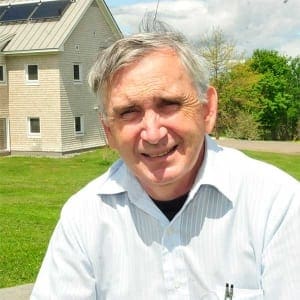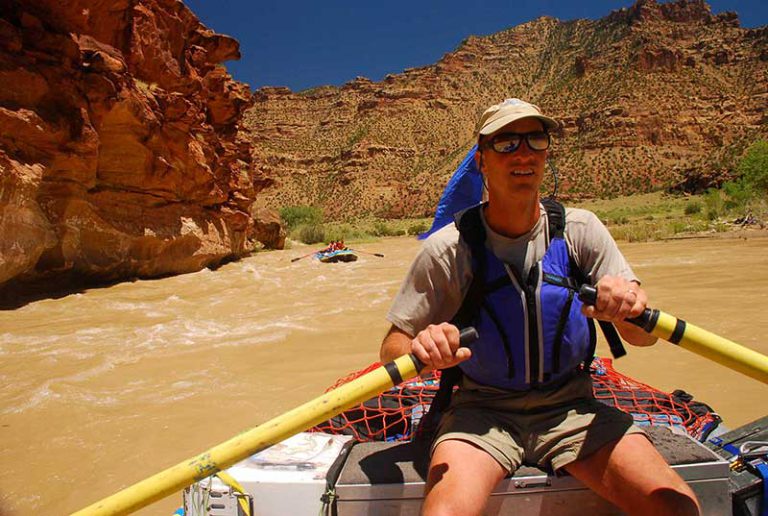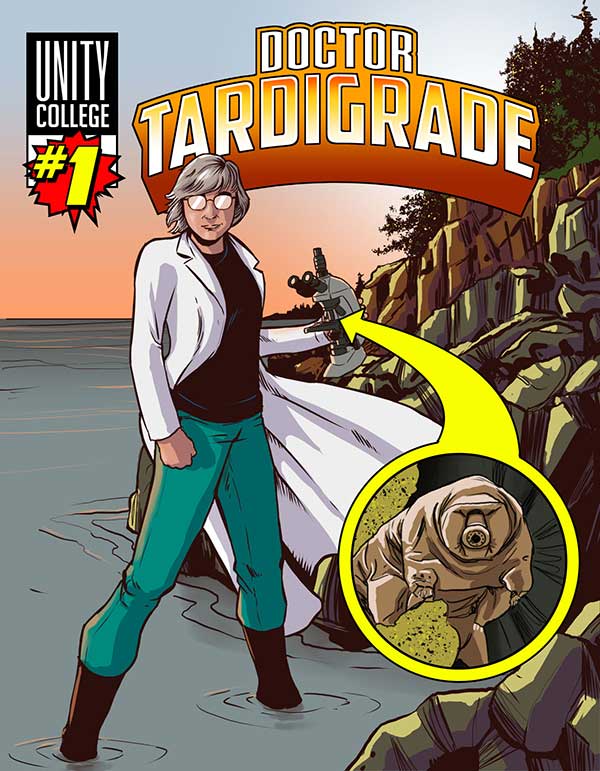
Academic Background
MS ED, Mathematics Education, State University of New York at Plattsburgh
BS, Secondary Mathematics Education, State University of New York at Plattsburgh
Barry Woods began teaching at Unity College in 1976. A native New Yorker and a die-hard New York Yankees fan, Barry earned his graduate and undergraduate degrees from the State University of New York at Plattsburgh, where he majored in mathematics and education.
At Unity College, Barry teaches primarily Statistics courses. His current interest is in the integration of technology into the teaching of his stats courses. From the use of hand-held calculators to computers, Barry encourages his students to be active learners and to take a proactive role in their own education. In 1989, Barry’s faculty colleagues awarded him the first Martin A. Rosinski Award for excellence in teaching.
Off campus, Barry has served as an AP-Statistics Reader and as an educational consultant for the College of the Marshall Islands and the Northern Marianas College in Saipan. In Maine, Barry has served on the Board of Directors for Operation Game Thief, a private, nonprofit organization that works in cooperation with the Maine Warden Service.
When did you arrive at Unity College?
I signed my contract on August 24, 1976. And I remember that day because it’s my younger brother’s birthday. So I came in the fall of 1976. July will mark the beginning of my 40th year here at the college. Four of the five decades.
What was the college like when you got here?
Like everyone else, I missed it. You know, there was a sign in town and I drove right past it. People close to me have heard me say this before. I interviewed with President (Dr. Allan B.) Karstetter and the dean was Robert Hunter, and Dean Hunter gave me a tour of the campus much like we do today. I finished with the president, and he asked me sincerely, “So what do you think of the college?” And I said, well, actually I haven’t seen a tour of the college yet. So he gets on the phone to Dean Hunter, and he comes in and said, “Mr. Woods I gave you the tour myself.” And I said, rather naively, yes I’ve seen this but I haven’t seen the main campus yet. I had no idea that this was the main campus. I had come from Plattsburgh, New York, and at Plattsburgh there’s a 4,000-student campus. And they had 10 miles away what was called, then, Man and His Environment … it was a small little satellite hub. I thought this, Unity College, was a small satellite hub of a larger main campus. And I remember driving home from the interview that night, got home to New York, said to my dad I will never work at Unity College because I told him the story.
… But things have a way of working out. So, I’m appreciative of the fact that they hired me. I know that I’m a much better person today because of the college. And, modestly, I believe that the college is much better today because I’ve been here. I take great pride in my teaching. And I think the alumni, I hope that they would echo that. But I’ve been really fortunate to work with great people. One of the things that I took to heart and still take to heart in the back of my mind, we had this stationery – and I’ll find you a piece of this stationery — with a tag line at the bottom of this stationery that read, “Come help us build a college.” And those of us who were hired in the 70s and 80s, we took that to heart. And the college … to watch it evolve, grow up into what it is today, people seriously took that to heart. And I believe we all helped build a college, and we’re still doing that today.
All the way to banging nails and raking the leaves, it sounds like ….
I have renovated the inside of Koons Hall twice, and we shingled the outside of Koons Hall once. And this is before … it’s been sided now. Because under the green siding were cedar shakes. And before Joe Bellerose, a great alum who’s done more than an alum’s worth of work on rebuilding the college, had done the East West corridor and the North South corridor. I remember working with Charlie Schaefer — Arlene Constable Schaefer, her husband – and we renovated classrooms where we painted the walls and had wainscoting halfway up the walls. And we installed blackboards. So yes, it was literally, “come help us build a college.”
Where Cianchette Hall is now, a group of Unity College [people], Unity Phone Company and just regular townsfolk … we built the first softball diamond on Unity College, because they had the soccer field but they wanted to play ball and they didn’t have a ball field, and we literally built a softball diamond where Cianchette is. And we would hit down towards the lake in the late 70s and 80s. We had games among the town people, college people, and I know Unitel had employee softball. OK, we weren’t any good at it, but we all had fun playing it. So we took that saying to heart, to help build a college.
I remember Wilson Hess was president, and he had the idea of the Loop Road. When you walk on campus now, you walk between the bollards of what’s called Murdock Drive. And that used to be the college drive. But having cars and students, OK, that wasn’t so safety conscious. So Wilson Hess had the idea to build the Loop Road, and the way we got funding to do it was because the Maine National Guard couldn’t build the Loop Road for access to the college library if it was just the college library. But because it was also the town library, the National Guard could come and build the Loop Road.
So I remember driving the pan truck, which is a big heavy-duty piece of equipment, you’ve got a hydraulic lever to open the door at the bottom, and it just scrapes all the dirt off. And so for a certain sum of money, OK, I got several attempts at driving this pan truck. And I actually helped carve out the road that what is the Loop Road today.
In those days, we seriously … everybody, there was no faculty, staff, administration, students. We were all in this together. And we seriously built a much better college than how we saw it. And some day when I do retire, probably in the next 50 years, I will look back on all the accomplishments the college has attained, and my small little part.
In getting to those goals [the college has set], I credit people with having vision. The person who played, I think, a significant role … in the 50 years, we’ve had one president serve more than five years, and that was Wilson Hess. … He had every job.
He came a semester after I [did], he came in the spring of ’77 as assistant dean registrar, and so he worked through the administrative ranks. We were both Center chairs. And he had worked his way up to being director of admissions and [director] of career planning and placement and other administrative tasks … And at some point, we honestly believed Wilson had every job on campus, including Dean. And then Bert Clifford hired him to be president. And in that decade, he got the college reaccredited.
In my time here, President Karstetter got the college its initial accreditation, I believe in 1974. The library was built in 1975, and they moved the books from the library that used to be at the back end of Koons Hall, those four classrooms, by human chain that passed books at a time from the back of Koons Hall to the back of the library. And when I came to interview in the summer of ’76, there was this beautiful building. I could not imagine a college without a library – in my opinion, the heart and soul of any college. So having missed the first decade, I was OK with that. But from anything on in the 70s, 80s, 90s, the 00s, and now into the teens, I’ve worked five decades here, and I think the college is much better. We look like a campus, not a collection of eclectic buildings that are mismatched. We have the Loop Road, and I still haven’t figured out how to get students on the inside of the Loop Road and the cars the outside of the Loop Road. But OK, someone with vision will figure that out.
But I like it. I like the design of it, I like the layout of it. I like the Field of Dreams. I think athletics can once again become more popular on campus. I’ve been softball coach, baseball coach, assistant basketball coach, along with many others who have coached. Gary Zane coached, Wilson Hess coached lacrosse and soccer and women’s volleyball. …
I’ve been fortunate to work with really good people. We’ve had outstanding faculty come through here. People like Ron Barry, Terry Boyer. Wildlife people Jim Nelson, Dave Knupp. … Fisheries people before Dave Potter. We had Hal Gray, Kevin Curry, Charlie Rabini. The college has hired exceptionally talented faculty. And the students who come here want the applied hands-on, haptic learning. (Haptic communication refers to the means by which people and other animals communicate via touch.)
So at graduation this past Saturday, what were some of the differences you noticed in the students?
You can look through my tenure and see that, when I first came, the majority of graduates were in a two-year associate of applied science degree program. We had 66 or 72 credits, something like that, for an associate of applied science, AAS, in addition to the 60 credits for associate of science or associate of arts, and there were very few baccalaureate degrees. And during my time, you could see that change: less associate’s, more baccalaureate. At some point, I dare say it was 50-50.
Now, I think a Unity College student comes here to earn a baccalaureate degree.
If something happens … they failed a senior course or, in the case of one of my advisees, two years it was financially over for him. And he said, I’m going to leave know, after two years. And I said you’re not going to leave until you get your degree. The young man had no idea you could earn an associate’s degree here. So, as an adviser doing my job, I said to the student … you can … satisfy all the requirements for an associate of arts or an associate of science degree.
But clearly, students come here for a baccalaureate degree. Now, that was not the case then.
That said, the students are very much the same. In my field of mathematics, we have more than our share of talented students who would be placed into a traditional freshman college calculus class and would do well. But the majority of our students are still mathematically challenged. They need some help in what we now call pre-Calculus or Algebra and Trig class.
When I first started teaching here, I taught with a slide rule. And if you want a photo op, I have a 4-foot slide rule that we would use in front of the classroom. Today, it’s all calculator and computer-based. I know some students have some facilitation with Wikipedia and they know how to Google, as a verb. They‘re good at email, and now texting. They’re not so good at number crunching, and that includes use of Excel. And I think students of the future will have to better understand Excel and databases. That’s where it’s at. Because all this information that’s being catalogued now, the data in the Information Age, students are going to have to retrieve that.
And that’s a goal in my courses that I teach. There’s a student learning outcome called “facilitation with Excel.” And students will tell you that, in my class, we will write Excel formulas. We will use the functions that Bill Gates gave us … it’s an outstanding spreadsheet, but I want them to see it [and use it] as a statistics package. And students like it because they are at least comfortable with [Microsoft] Office, as opposed to learning a new package such as, the college uses something called JMP, built by a company called SAS. And it’s a great statistics [package], but it’s not so much a [user-friendly] spreadsheet for students. So I’m trying to bridge a very good spreadsheet into making it statistics-capable, at least for the intro and intermediate level Statistics classes. For the advanced students, they understand that if you take a biometry class, you’re really doing some high-powered statistics [and should use JMP].
Math might be one of those disciplines that hasn’t changed in decades, but the way you teach it and apply it has ….
How we teach it has changed. In my early tenure here, it was all paper and pencil work. And I remember seeing the first computer on this campus, which was a huge, it’s larger than this part of your desk here, and it had a couple of cassette tapes. We would run, I think there were 50 programs. Mine was like Number 17. So you typed in 16 so it would fast-forward the first 16 programs on the tape then it would load the 17th. That was to do a simple t-test (an inferential statistics test used to compare a sample mean to a population mean). Today a student can do that on their smartphone, because there’s a TI (Texas Instruments) app for their smartphone. And I encourage the use of technology in the classroom. And I have students who have not purchased a physical TI 83, 84 calculator, to download a virtual calculator so we can do statistics, either on a physical plastic one or electronically on their computers.
So the tools with which I teach have changed. Paper, pencil, slide rule … out. I remember the LED calculators, I remember computers, AppleWorks … VisiCalc on floppy discs. The tools have changed. But it’s still, how are you going to apply mathematics to the solution of real-world problems?
Students, I think, more easily understand the importance of statistics because it’s something they can relate to. Calculus is a little more theoretical, and therefore they have a harder time relating to it.
I’m fortunate. At the request of my science colleagues … they saw the quantification of science taking place, and that revolution was in the 1980s. They suggested we offer an intermediate statistics course. … We learned statistics from six different professionals who were using statistics in their field. So that has been very beneficial.
Now we have community-based learning. I work with Dave Potter on Fisheries for Lake Winnecook and go to his labs three days a week, and sit in on his lectures, and he writes or the students compile portfolios. And to quote Dave, the worst electronic portfolio today is better than the best one we had a decade ago. So that’s changing. And I know Dave submits a report to [the Maine Department of] Inland Fisheries and Wildlife, and I know statistics are in that report. And I would like to do the same thing now paired up with the big topic on campus that everyone’s all excited about right now, and that’s the Unity College bear study. So with [faculty] like George Matula and Brent Bibles and others, we have data collected on Waldo County bears, or Wildlife Management District 23 bears. OK, how can we compare and contrast those with the other wildlife management districts? The students are all excited about this.
They still have their commitment to the environment. That’s never changed. From before Earth Day was started, Unity College was an environmental school. So we were a champion of the earth and the environment long before it was ever cool. I’m pleased that that has continued.
What will a graduate 20 years from now learn about applied mathematics?
A lot more data mining. They will still use mathematics as a tool. It’s a lot like the three “r’s.” When their parents went to school they were “reading, ‘riting and ‘rithmetic.” Now the 3 “r’s” are respect for yourself, respect for others and responsibility for your own actions. And there are the “3 c’s” which stands for communicating, both oral communication and written communication; calculating; and computing.
But, general education when it was first introduced here, it has not changed. There is an English component. There is a science component. There is a mathematics component. There are life and physical sciences. There are the arts that enrich us all. I agree with that.
I was fortunate enough to do most of my early team teaching with [Leonard] Craig, for whom the gallery [at the Unity College Center for the Performing Arts] is named. My early thesis work with students was done with Leonard Craig, a man with vision, who brought the arts to life on this campus. Now while I do most of my thesis work with a science colleague, arts with Ben Potter is still very much seen on campus. …
But mathematics, I don’t think is going to change how we teach it. For the students, facilitation with mathematics and the ability to make sense out of data is what’s going to change. We are data overloaded, if you will, and how are students going to sift through all of that data to come to meaningful conclusions, and what story is that going to tell in the years to come? So it’s how students are able to handle the data. And they’re bombarded by it every day. The use of statistics will become even more important.
Someday in the future, I would imagine that it won’t be just one math course that’s a general education requirement. It may be a math course in depth in your discipline such as calculus, and a statistics course for an overview. At some schools, I know statistics is the general education course. As the faculty member that teaches statistics, I’m not yet ready to make that suggestion, but if it came out of a general education conversation, I would strongly support it.
There’s some sort of … what we call it now is quantitative literacy, and it’s the ability to decipher graphs, make sense out of enormous data, put it in a table so that it’s understandable and a graph so that it’s visual for the visual learners, and then present it in a way that’s meaningful. So the communications piece is still key. So I applaud the college. We’ve combined composition and communication into a two-semester sequence, and that was a good idea.
I like the way we’ve progressed. And I like that the faculty have had input into the decision making process. When it comes right down to it, I think the faculty are at the core of this institution.



